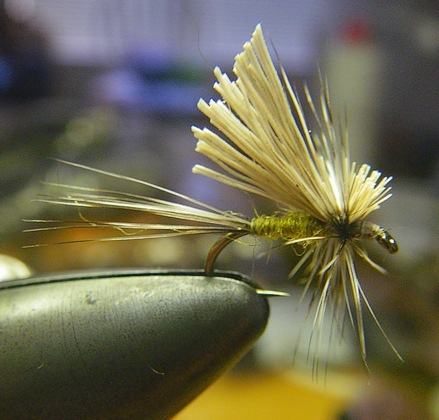It’s the simplest of all games really, each Saturday evening I sit down at the vise to invent the next great dry fly series that will revolutionize the surface game, and make everyone forget them ancient fuddy-duddies like Skues, Halford, or Ronald McDonald …
Rules are simpler yet; it has to be as fast or faster to tie than a traditional dry fly, and it has to use at least one waste byproduct of fly tying – some butt end or common scrap we’ve discarded routinely.
That way I can insist mine’s better than Theodore Gordon’s halting imitations as my fly is “green” as well as guaranteeing an early supper …

I’m not sure I was supposed to come up with anything at all, it was the challenge that drew me to the vise week after week.
I reversed the wing from a Quigley Cripple using deer hair trimmings as the discard material. His Cripple uses the trimmed stub over the body, and the long end over the eye of the hook. I added a dab of tacky wax to the wing … just enough to add a bit of clumping (for the mayfly version) and allows me to pull the wing down over the body to turn the fly into a caddis imitation.
Pull the wing up for the mayfly hatch and down for the caddis grab – neither requires you to retie the knot when it’s near dark.
What’s not to like in a fly that can imitate two of the major trout food groups?
The real test of a great fly is not in its design or function but in the hidden meaning of its name, which will naturally be lost over time, yet adds mystery and illusion to a pedestrian effort.
There were two royal coachmen for each carriage, so which inspired the fly?
I call it the “Hovering Predator” which we’ll know as the drone that’s kept Osama behind them high walls and rooted to the compound, and the rest of history will have to guess at – while wadding handfuls of #16’s into their fly boxes.
Better yet, I’ve shown you mine, now I want to see yours …

“The two Major Trout food groups” Old son, Global warming has not produced a trout above 8″ in California in 24 months. Asian carp is now the God-Emperor of sport fishing on any coast. Crap blogging like that on trash fish will reduce you to the back pages of blogging.
When I was taught to tie flies, it was always drilled into my head to make sure I used the tips on all of my patterns.
Is this something that you have noticed isn’t important in fly design?
In the design phase the concern is merely:
“will it float upright”
“will the wing topple the pattern”
“do I oversize the hackle to give it a broader stance”
” do I increase the tail length to give it more stability”
In the above case, I had chopped deer hair leavings on my vise from earlier flies, and the rules of the contest was “use some fly-tying discard on the fly.”
No, it is not necessary to use the tips at all – spun deer hair flies like the Goddard Caddis and the Rat Faced McDougal are testament to the issue.
In most cases you’re paying for the tips – so you don’t want to use your best stiff, non flaring hair …
Great question.
Pingback: Great Stuff from the FFlogs Today…..
I doubt most (any?) fish can tell the difference between a fly tied with the “tips” vs. a fly tied like Kieth’s concoction (mongrel?). But most (all?) snooty anglers would gobble the “tip” tied flies up like gum-balls.
I’d say the real test is will it catch fish? I’ll hold off judgment until I see it wet and in the corner of something’s mouth.
A couple of questions:
Have you tried tying the hackle in parachute-style? Not sure how that would affect adjusting the wing, but you’d get more of the bug in the water that way.
Did you use one of your nymph dubbings for the body?
As always you’re on target, Joe – I’m working on the parachute version as we speak. Actually two seperate versions …
The first would have a small bulb of dubbing behind the wing that I would flair the hair around 180 degrees, making a half-cone. This would allow fibers in the water to assist in flotation – and steady the fly right-side up.
The second is a traditional parachute, but it appears the hackle will remove its ability to draw the wing downward and turn it into a caddis.
If a trout eats a cigarette butt, it’ll eat anything. Effectiveness is the least of my issues – as I’m almost always fighting the physics.
I still (marginally) prefer Lee Wulff’s “Wretched mess”. As it’s totally tied with refuse, not just partially.
But I like this pattern very muchy. It looks balanced, catchy, and salable. Good stuph, Keith!
Pingback: Fling it upstream then mash the button as it goes by | Singlebarbed
Pingback: No, the Other Brown One … | Singlebarbed
Pingback: We left the beads at home, enjoying the spectacle of “weightless” fishing for a change | Singlebarbed